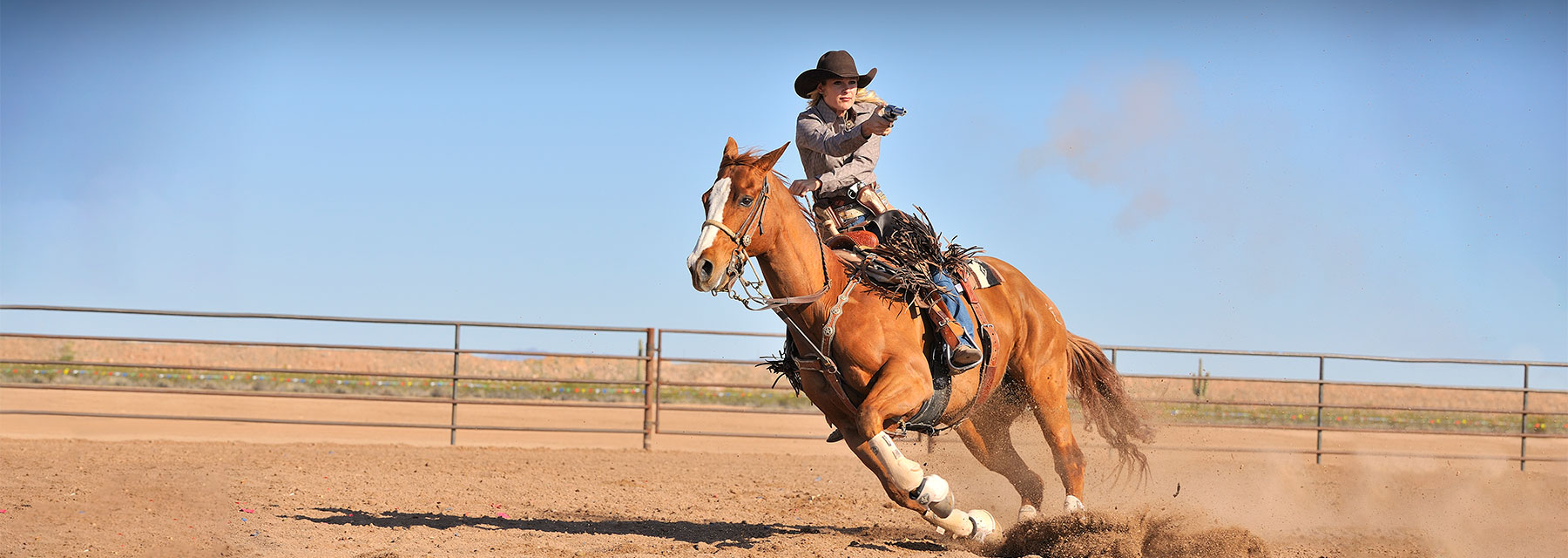This blaze-faced gelding, Lieutenent Justin, helped Kenda Lenseigne win two CMSA Overall World Championships among countless other titles and accolades.
The Overall World Champion Mounted Shooter Talks About the Thrill of Competition and Horses That Have Taken Her to the Top
John Wayne. The iconic movie star of the Wild West — whose name still resonates with courage, grit and sharpshooting — brought the great American frontier to life with his fierce bravery and compassion to fight for what was right. The untamed frontier that The Duke protected is a part of our history that is dangerous and fascinating all in the same breath. This is the reason Wayne’s movies remain timeless and why many traditions from this era continue today. One such custom is the sport of mounted shooting.
Like The Duke, Kenda Lenseigne is rarely seen without her trusty steed at her side and a holster on her hip. Watching her compete is like stepping into an old Western movie where cowboys risked their lives for land, freedom and the greater good. She confidently enters the arena atop an Old Foundation Quarter Horse ready to take on her opponent, in this case, 10 balloon targets placed in a pre-determined course around the arena. She is ready for battle; she’ll wage a fight against the clock and her own accuracy to hit every target. The skills she uses are the same skills her ancestors so bravely perfected to fight for our country. She’s an icon in this sport, setting fourteen world records and winning Cowboy Mounted Shooting Association’s (CMSA) Overall World and National Championships multiple times making her the first and only cowgirl to ever claim this coveted award.
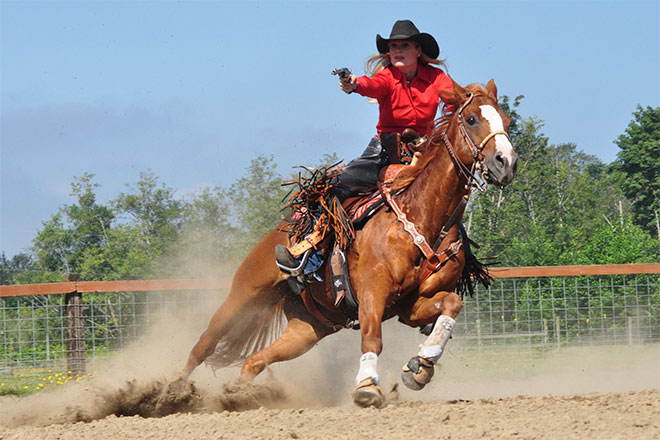
PHOTO BY ELIZABETH HAY PHOTOGRAPHY
“I thought this is something that I would like to do! I enjoyed the timed aspect of it, the horsemanship and figured I could learn the mechanical skills of handling the firearms over time.”
— Kenda Lenseigne, 4-Time CMSA Overall World Champion and 5-Time CMSA Overall National Champion
Kenda Lenseigne came into this sport with no experience shooting, and almost 24 years later, she’s the only woman in the history of mounted shooting to win the CMSA title of Overall World Champion.
A Closer Look: The Sport of Mounted Shooting
Inspired by the Wild West shows that romanticized the great American cowboy and the open frontier, mounted shooting became a competitive sport in the 1990s. It can be summed up as 10 targets, two guns and five rounds in each gun. The sport requires skills in both horsemanship and shooting as the rider navigates a predetermined course to shoot 10 balloon targets as fast as possible. The course requires horse and rider to turn barrels, change directions and hustle through narrow openings all while shooting the balloon targets along the route. A missed target costs the competitor a 5-second penalty making accuracy just as important as speed and efficiency.
The Beginnings of a Star
Lenseigne grew up as a typical horse crazy girl, riding alongside her mom in rural Washington, then branching out on her own to learn from different horse trainers around the country. “I’ve been riding horses my whole life in all different disciplines,” she says. It was in her early 20s working in California as a cutting horse intern where she first watched a mounted shooting event in 1998. “The sport hadn’t been around for very long at that time, and it was quite wild back then,” she explains. “Coming from those other disciplines to mounted shooting, it was definitely a shock! If I can put it lightly, going from Western pleasure, English pleasure and all the judged events with all the proper things to the sport of mounted shooting — was like coming to the Wild West, and it was truly wild.”
From there, Lenseigne says she was “lured” into trying the sport by friends who were already involved in it. “They actually put me on the spot at a demo they were doing during a Western festival. They were making a point — about how easy and fun the sport is that anyone can do it — by picking a random person out of the crowd to try it. Well, that random person they pointed to was me because they knew me!” laughs Lenseigne. Even though she only hit two of the 10 targets that day, she was hooked: “I thought this is something that I would like to do! I enjoyed the timed aspect of it, the horsemanship and figured I could learn the mechanical skills of handling the firearms over time.” Her friends didn’t know it, but they had awakened a lion in the sport of mounted shooting that day. Lenseigne remarks: “I started by borrowing everything — guns, horses, equipment, everything. The saddle that I was riding was 10 times too big for me, but I didn’t care, I just wanted to go and enter.”
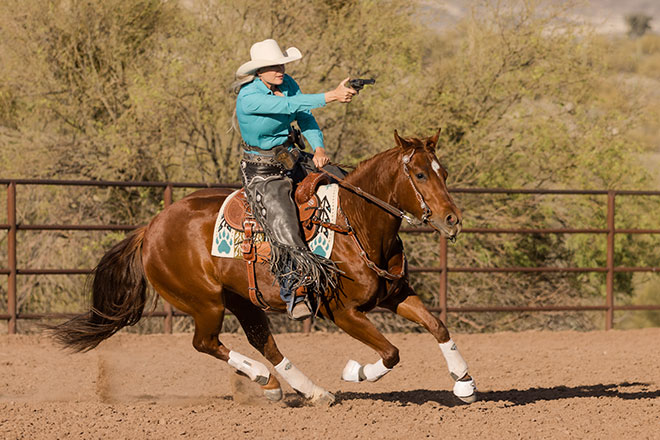
“There’s a place for everyone in this sport. Mom, dad, kids, grandma and grandpa can all compete at the same event. You see a lot of families doing this together, literally from 75 years old all the way down to the little kids.”
— Kenda Lenseigne, 4-Time CMSA Overall World Champion and 5-Time CMSA Overall National Champion
Sparky is the superstar mare that helped Kenda Lenseigne win a pair of CMSA Overall World Championships after Justin was retired.
The Horse That Changed Her Life
Lenseigne admits that she wouldn’t be at the top of her sport and making a career out of mounted shooting without gifted equine counterparts. In fact, one of her most treasured partners still lives the quiet pasture life on her Arizona ranch — his name is Lieutenent Justin. This blazefaced gelding helped get Lenseigne to the big stage where they would win two CMSA Overall World Championships among countless other titles and accolades. “Even though he’s retired now, he’s still the love of my life,” she says. “He’s definitely earned his place as a legend in our barn and also in our sport. There are so many people that are big fans of him, and I am too.” Justin is 25 now and although he has experienced his fair share of hardships, he is still thriving.
Comprehending Justin’s strong will and tough nature is impossible without knowing his comeback story following a 2015 accident. Lenseigne recalls: “A couple months after we had won another world championship, we were out practicing, and he completely shattered his leg.” In the emergency room with her beloved partner, she explained to the veterinarians that they needed to do everything to save him. “Justin spent seven days in the hospital, and he had a big cast on his back leg where they had put the screws and plates in,” she says. Although his recovery wasn’t easy, Justin was able to defy the odds and come home to heal.
Two years later, Lieutenent Justin was back in the arena. He was no longer fast enough to compete at the pro level with Lenseigne on board, but he was doing what he loved and teaching new shooters what a good horse should feel like. “His last hurrah was a big championship in Las Vegas where one of my students, who was an entry-level shooter, rode him,” Lenseigne says. “She won everything she entered on him — her class, the Eliminator finals and the Double Down finals. I didn’t even care how I placed that weekend because I was so proud, and it was clear that so was Justin by how ‘big’ his demeanor showed after each run.”
Kenda’s Success
2022 Reserve Overall Cowgirl CSMA Winter Championship; Overall Cowgirl Appalachian Mountain Champion
2021 USMS Open Futurity Champion (aboard Winston); Overall CMSA National Reserve Champion Cowgirl and High Money Winner; Overall Cowgirl Appalachian Mountain Champion
2020 (Events Canceled)
2019 Overall CMSA National Champion; Overall CMSA Winter Champion
2018 Overall CMSA World Champion; Overall CMSA National Champion; Overall CMSA Western US Champion
2017 Overall CMSA World Champion; Overall CMSA Western US Champion; Overall CMSA National Champion; Overall CMSA Winter Champion
2014 Overall CMSA World Champion
2013 CMSA Western US Champion
2012 CMSA Western US Champion; Overall CMSA National Champion; CMSA Winter Champion Cowgirl
2011 CMSA Central US Overall Champion
2010 Overall CMSA National Champion
2009 Overall CMSA World Champion
The Makings of a Mounted Shooting Horse
Out of everything that Lenseigne has won in mounted shooting over the past 24 years, in her eyes the biggest accomplishment is training the horses she rode. She explains, “What I feel best about is that I’ve been the one putting all the work into these horses, and they’ve brought me to the winner’s circle. I don’t send them off to a trainer, it’s all my tens of thousands of hours that I have put into them to make my team. That’s something I’m most proud of.”
What Lenseigne is not exaggerating about is the time it takes to make a finished mounted shooting horse. The beauty of the sport is that it requires talent in many different areas, including speed, agility and brains to adhere to the pressures of the event. “A good mind is the key to this equation,” she explains. “I look for horses that are smart, willing and can turn on a dime. They’ve just got to have a good head on their shoulders to make a (successful) mounted shooting horse.” The same is true for most horses that competitors use in any discipline, but it’s especially true for Lenseigne’s horses because of the added stress that comes with the sound of gunfire.
The unique and challenging aspect of training a mounted shooting horse is desensitizing them to the noise. Although the sport only allows for blanks to be shot, meaning there are no bullets involved, there is still a very loud noise that comes with firing the ammunition. Lenseigne uses a step process to gradually help a horse feel comfortable competing in mounted shooting. She explains: “I always start with the buddy system, meaning that I pair up the new horse with a seasoned horse, and we just walk or jog around the arena. I have found over the years that if you buddy up a young horse with a confident horse, then that confidence kind of rolls over to the newbie.” She will start by using a lesser sounding .22 caliber gun and shooting blanks that are made for a nailgun, first while riding the seasoned horse, then on the young horse. “It’s just enough of a crack to start the noise process,” she says. Once the young horse is comfortable with this sound, then she will move up to a half-loaded .45 caliber (half the powder, half the noise) until the horse is finally comfortable with .45 caliber blanks that are used in competitions. “At that point, I start to incorporate the balloon targets because sometimes the horse will be like, ‘OK, I’ve got this noisy thing down, but why is the balloon exploding?’ ” Lenseigne jokes. Like any good horseman, her philosophy is always to first assess the horse and never rush the process. Every animal is different, but on average, it takes Lenseigne about three months of consistent work to get her young horses used to the sound of gunfire.
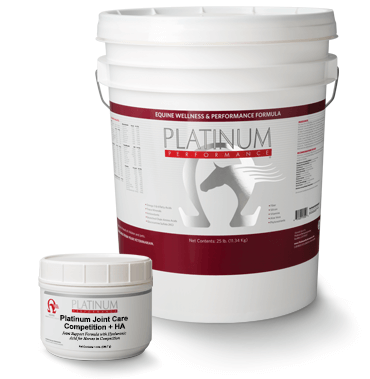
Kenda’s Formulas for Success
Platinum Performance® Equine
The Equine Wellness and Performance Formula
Platinum Joint Care Competition + HA
Joint Support Formula with Hyaluronic Acid for Horses in Competition
The Nutrition That Works
Lenseigne has been a Platinum Performance® client since 2008 when the formulas were recommended by trusted peers. “It was just an easy decision for me to make because it had everything in it my horses needed,” she says. “If a person sits back to simply observe the whole herd and can say every single horse here looks really good, they all look bright and healthy. What’s the secret? It’s visual and viable proof in feeding Platinum. I have folks come up to me all the time and ask what it is that I’m doing because all of my horses look so good.”
Due to the stresses her horses endure from stopping, turning and running hard through their patterns, Lenseigne supplements them all, regardless of age, with Platinum Performance® Equine and Platinum Joint Care Competition + HA. These two formulas combine all the vitamins and minerals necessary for daily health with an advanced level of joint support to keep these athletes performing at their best. “We use these horses hard, they’re not just pasture pets, and that extra compound of joint nutrients gives them the support they need. It just makes total sense to me. I mean if I feel creaky, I’m not going to give my best and I know the horses aren’t either,” she explains.
Her Horses’ Bloodlines:
Justin: Lieutenent Justin
Sire: Docs Farewell, with Doc Bar,
King Fritz and Lucky Bar all in his bloodlines
Dam: My Easy Elegance
Sparky: My Familys Famous
Sire: Starlight Shiner by Shining Spark
Dam: Twig Of A Hickory by Docs
Gay Hickory
Winston: Justin Timeto Shine
Sire: Starlight Shiner by Shining Spark
Dam: Nobel Pleasure by Docs
Farewell and out of My Easy Elegance
Sticking With What Works
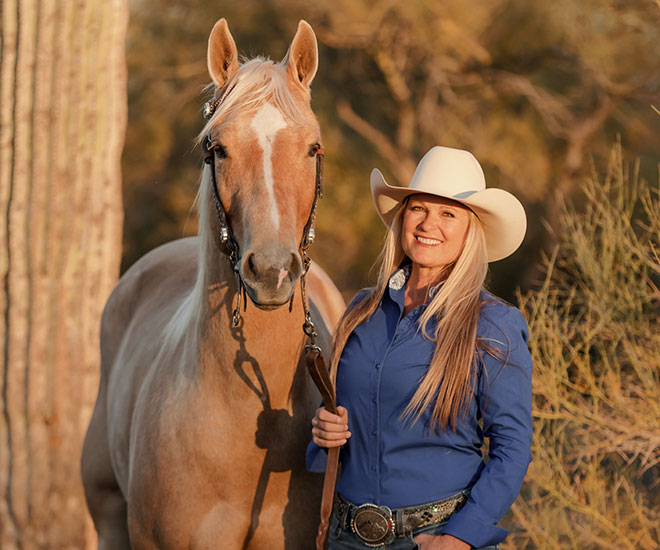
Justin Timeto Shine, aka Winston, is currently Kenda Lenseigne’s main mount. He’s Justin’s nephew and Sparky’s brother
When horsemen find the right breed, they like to stick with it. For Lenseigne, it was that and more. She decided to mix the bloodlines of her two best horses: Lieutenent Justin and Sparky, the superstar mare that helped her win a pair of CMSA Overall World Championships after Justin was retired. Together, these two helped Lenseigne become an icon in her sport; and now she is hoping to honor them both by taking their pedigrees to the next level. As luck would have it, she was able to find a full sister to Justin and breed that mare to Sparky’s sire, Starlight Shiner by Shining Spark. From this union five years ago, a beautiful palomino stud colt was born, which she named Winston (registered as Justin Timeto Shine). Lenseigne says, “Winston is my main mount now. He’s the best of both worlds because he’s Justin’s nephew and Sparky’s brother.” With the track record she’s had on his predecessors, she undoubtedly has high hopes for this young colt’s future. “I want to try and build something solid for the long game with him,” she says.
In true John Wayne fashion, this straight shooter charges onward, working hard for what she’s passionate about: her horses and the sport of mounted shooting. She came into this newly-developed sport with no experience shooting, and almost 24 years later, she’s the only woman in the history of mounted shooting to win the CMSA title of Overall World Champion. With her hopes and dreams set on making Winston the next champion, her fans are excited to see what Lenseigne will accomplish next. There’s no doubt that with her hard work and determination, she can shoot for the stars.
Mounted Shooting Basics
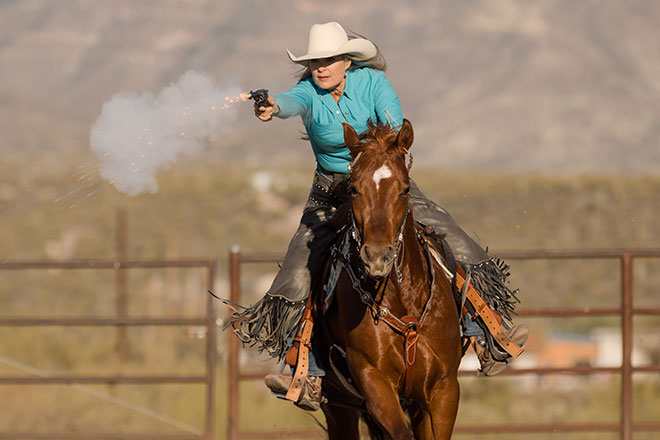
Guns: Mounted shooters carry two .45-caliber, single-action revolvers that resemble firearms used by cowboys after the Civil War. Single-action revolvers have to be cocked before each shot is taken making this another key challenge for competitors.
Draw Pattern: Each competitor runs a specified course that consists of 10 balloons that the contestants must pop. A typical pattern consists of five red balloons and five white balloons. The white balloons are spread throughout the arena, and the rider must shoot these balloons before moving on to the red balloons that are lined up in a row, called “the rundown,” straight toward the finish line.
Scoring: Riders are scored on time and accuracy. Each missed balloon, downed barrel or dropped gun is a 5-second penalty. If the dropped gun is loaded, the rider will also incur penalties for the missed targets as a result. Riders are not allowed to stop and pick up a dropped firearm unless it has occurred before or after the timing line. Other penalties include 10 seconds for going off pattern and 60 seconds for falling off the horse.
Loading Zone: Guns are kept unloaded until each competitor enters the designated loading zone, which is sectioned off from the rest of the warm-up area. Only riders who are getting ready to run are allowed in this area, and they may not leave once their guns are loaded.
Range Master: This judge is generally an experienced mounted shooter who has training in safety practices. The Range Master is responsible for keeping the competition running smoothly, assessing penalties incurred by shooters and maintaining a safe environment. New contestants are required to demonstrate their riding and shooting skills to this individual before the start of competition.
Safety Meeting: Each competition starts with a safety meeting that outlines the safety rules of the day. If any rules are broken, riders are disqualified and receive a no time.
Levels: Most mounted shooting events have divisions for men, women, seniors and youth with subcategories based on skill level. Riders start in Class 1; after winning that class four times, a rider advances to the next class. The number of wins required to “move up” becomes greater as the levels get higher. Level 6 is the highest and considered the professional level.
Dress Code: Contestants are required to dress in Western attire. This includes a long-sleeve Western shirt, jeans, chaps or chinks, boots and a cowboy hat. Riders can wear modern Western clothing or dress like they would in the 1800s.
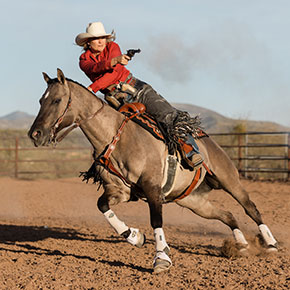
More in Our Podcast; Subscribe Today
Guns Blazing: A Podcast with Kenda Lenseigne
Kenda Lenseigne, a CMSA Overall World Champion Mounted Shooter, talks about the thrill of competition and the horses that have taken her to the top.
Listen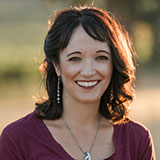
by Lindsey Stornetta,
Platinum Performance®
